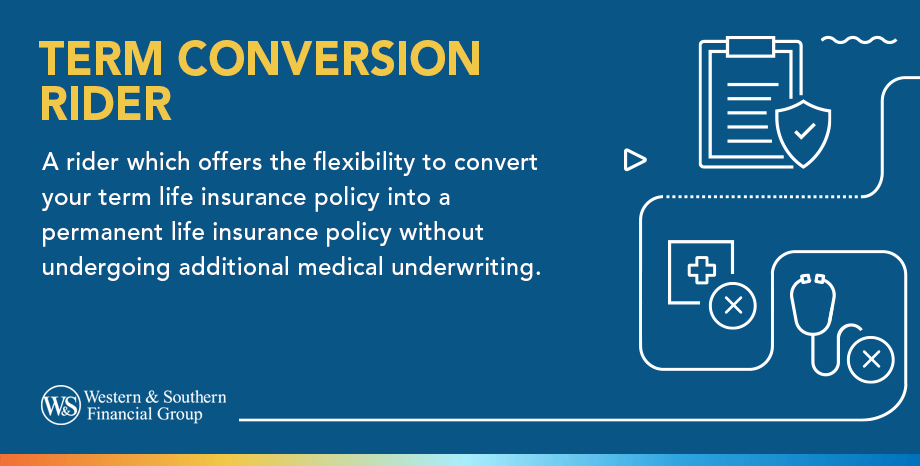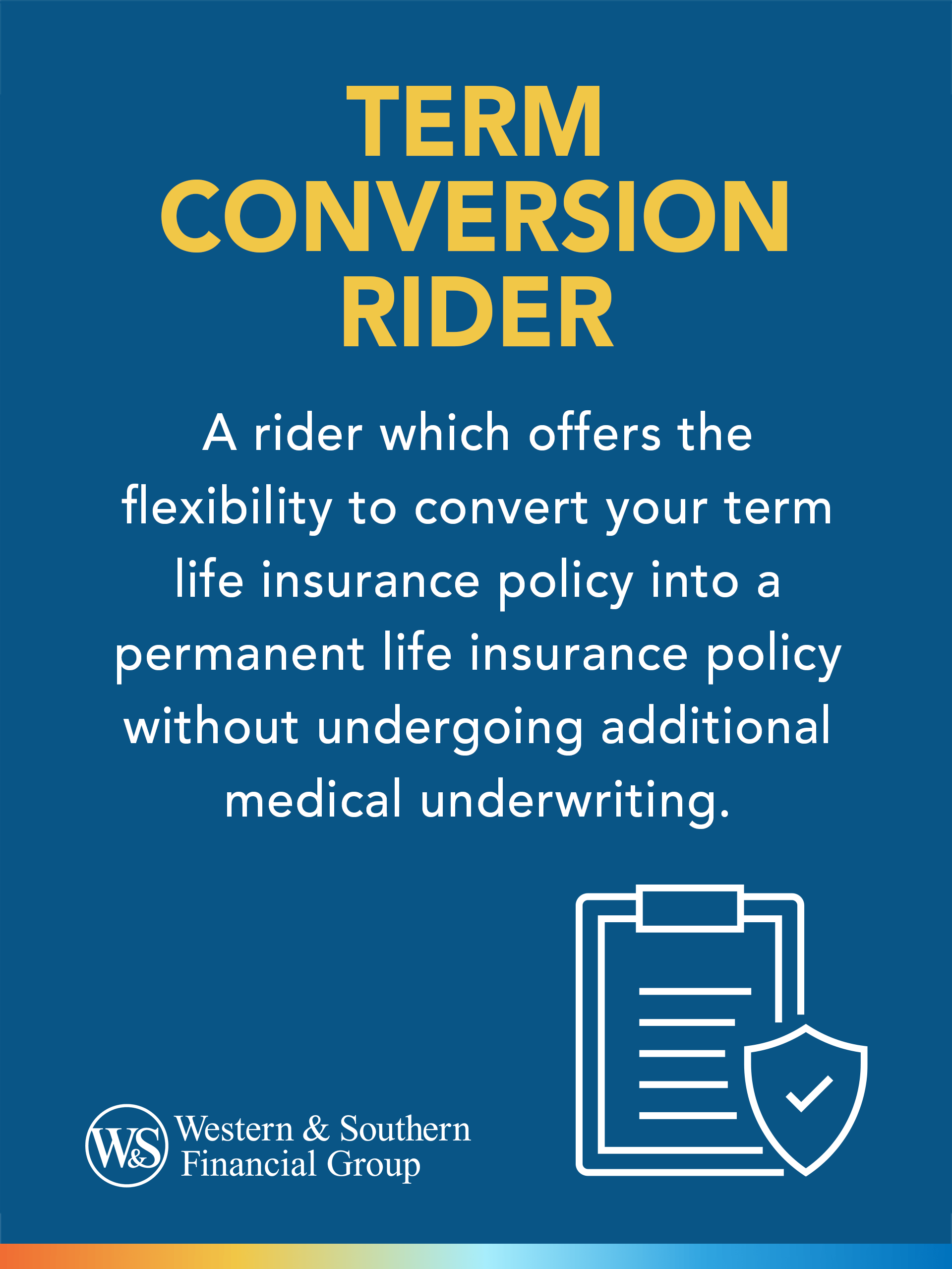Table of Contents
Table of Contents


Key Takeaways
- Term conversion riders offer the flexibility to convert your term life insurance policy into a permanent one without a new health exam.
- This provision allows policyholders to secure permanent coverage, even if their health has deteriorated, safeguarding their insurability.
- Term conversion riders provide coverage adaptability to suit changing life and financial circumstances.
- It's crucial to understand the specifics of term conversion riders as they can vary between insurance companies and policy terms.
- Conversion typically leads to increased premiums due to the lifelong coverage and cash value component of permanent life insurance policies.
What Is a Term Conversion Rider?
With a term conversion rider, you have the flexibility to convert your term life insurance policy to a permanent life insurance policy without undergoing additional medical underwriting or providing additional evidence of insurability.
Term life insurance provides coverage for a specified period, or "term" (typically 10, 20, or 30 years), and if the policyholder is still alive at the end of the term, the coverage ends. On the other hand, permanent life insurance, such as a whole life insurance policy or universal life insurance policy, provides coverage for the entire lifetime of the insured and typically includes a cash value component.
With a term conversion rider, you have the flexibility and assurance that your life insurance policy will adapt to meet changing needs. So remember, when choosing an insurer, consider one that offers this invaluable add-on!
What is the difference between a term conversion rider and a term rider?
A term rider is an additional feature that can be added to a permanent life insurance policy. It provides coverage for a specific period but does not offer lifelong protection. This option can be cost-effective, but it is important to note that it does not provide long-term security.
A term conversion rider allows you to convert your term life insurance into permanent coverage without the need for additional medical examinations. This means that regardless of any changes in your health condition, you can ensure long-term security for yourself and your loved ones.
The decision between these two options depends on your individual needs and circumstances. If you are looking for temporary coverage with lower premiums, a term rider may be the right choice. However, if you desire lifelong protection with higher investment value, a term conversion rider may be more affordable and suitable.
What is convertible term life insurance?
Convertible term life insurance is a type of term life insurance policy that by default, includes a feature allowing the policyholder to convert the term life policy into a permanent life insurance policy. This conversion can be done without having to undergo further medical underwriting or proving insurability.
How Does a Term Conversion Rider Work?
A term conversion rider works by allowing a policyholder to convert their term life insurance into a permanent life insurance policy at any point during a specified period, or before reaching a certain age, without the need for additional medical underwriting. Here's a step-by-step process to illustrate how it works:
Purchase of Term Life Insurance Policy: The policyholder initially purchases a term life insurance policy with a term conversion rider. This term life policy provides coverage for a predetermined period, such as 10, 20, or 30 years. It is important to verify if your term life insurance policy is convertible, as not all policies have this option available.
Decision to Convert: At some point during the term, the policyholder decides to convert their policy. This decision might be prompted by various factors, such as changes in their health status, financial situation, or personal circumstances. It's important to note that there's typically a deadline for converting policies, which may require the conversion to occur before the term policy expires or before the policyholder reaches a certain age.
No Additional Medical Underwriting: The key advantage of a term conversion rider is that the policyholder doesn't need to undergo additional medical and underwriting processes at the time of conversion. Even if your health has worsened since the initial purchase of the policy, you can still convert to a permanent policy without your health status influencing the premium rates.
Conversion to Permanent Policy: The term policy is converted into a permanent life insurance policy, such as whole life or universal life insurance. These types of policies offer lifelong coverage and can also build cash value over time. When considering converting your policy, it's important to remember that the terms and conditions can vary. Some policies may allow for partial conversions, meaning that only a portion of the term coverage is converted while the rest remains as a term policy.
Adjustment of Premiums: After the conversion, the policyholder's premiums generally increase. This is because permanent life insurance is more expensive than term life insurance due to the lifelong coverage and cash value component.
Continued Coverage: The policyholder now continues their coverage under the new permanent life insurance policy, with the policy's death benefit remaining in force as long as they continue to pay the premiums.
It's important to note that the specifics of these riders can vary widely depending on the insurance company and the specific policy terms and conditions. Always review the policy's details and consult with an insurance professional to fully understand the benefits, limitations, and costs.
What Are the Benefits of a Term Conversion Rider?
A term conversion rider can provide several potential benefits for those who have a term life insurance policy. Here are some key advantages:
- Flexibility: It provides the policyholder with the flexibility to change their insurance coverage as their needs change. For example, if a policyholder initially only needed coverage for a specific period, but their circumstances change, they might want to convert to a permanent policy.
- No Additional Medical Underwriting: The policyholder can convert to a permanent life insurance policy without having to undergo additional medical underwriting. This means that if their health has deteriorated since the time they took out the original term policy, they won't be charged higher premiums than they would have been if they'd initially taken out the permanent policy. In fact, they can convert to a permanent policy at the same health classification they had when they first took out the term policy.
- Guaranteed Coverage: Once converted to a permanent policy, coverage lasts for the policyholder's entire lifetime (as long as premiums are paid), compared to a term policy that provides coverage only for a specific period.
- Cash Value Accumulation: Permanent life insurance policies typically have a cash value component, which can grow over time. This can be used as a form of savings or investment that the policyholder can borrow against if needed.
- Protection Against Insurability Risk: If the policyholder's health issues significantly worsen or they develop a serious illness during the term of the policy, they might not be able to qualify for a new policy or their premiums may significantly increase. A term conversion rider helps protects against this risk by allowing the policyholder to retain their insurance coverage.
Potential Drawbacks of the Term Conversion Rider
While a term conversion rider offers valuable flexibility and potential benefits, it's important to consider the potential drawbacks as well:
- Higher Premiums: Permanent life insurance policies, such as whole life or universal life, typically have much higher premiums than term life policies. When you convert your policy, your premiums will increase, potentially significantly. You'll need to consider whether this increased cost fits into your financial plan.
- Limited Conversion Period: There's usually a limited time period during which you can convert your term policy to a permanent one. This is often before the end of the term or before you reach a certain age. If you miss this conversion window, you lose the opportunity to convert.
- Limited Policy Options: Some insurers may limit the types of permanent policies you can convert your term policy into. For example, they might only allow conversion to certain types of whole or universal life policies and not others.
- Complexity: Permanent policies, especially universal life policies, can be more complex than term policies. They often involve investment components and more complicated fee structures. This can make it harder to understand exactly what you're getting and whether it's a good deal.
- Opportunity Cost: The cash value component of permanent life insurance is often pitched as a form of savings or investment. However, these components often don't offer returns as high as other investment options might. Therefore, you may be better off buying a term policy and investing the difference in premiums.
While a term conversion rider can help provide a peace of mind and flexibility, it's not always the best option for everyone. It's important to weigh these potential challenges before deciding on a term conversion rider.
How Much Does a Term Conversion Rider Cost?
The cost of a term conversion rider can vary widely depending on several factors, including the insurance company, the specifics of the policy, and the individual's age and health at the time the initial policy is taken out. In many cases, the term conversion rider may be included in a term life insurance policy at no additional cost. However, some companies might charge extra for this feature.
It's important to note that while the rider itself may be free or relatively inexpensive, converting a term life insurance policy into a permanent policy will generally result in a substantial increase in premiums. Permanent insurance policies, such as whole life insurance or universal life insurance, are more expensive than term policies because they provide lifetime coverage and have a cash value component.
The exact cost of the premiums after conversion will depend on the amount of coverage, the type of permanent policy chosen, and the age and health rating of the insured at the time the initial term policy was purchased. The premiums would be calculated as if the insured had purchased a permanent policy of the same type at their age and health rating when the term policy was initially taken out.
Is the Term Conversion Rider Right for You?
Whether a term conversion rider is right for you depends on a variety of factors and personal circumstances. It can provide value for some but not necessarily for everyone. Here are some considerations to help determine if it's right for you:
Future Insurability Concerns: If there's a chance your health might significantly worsen, making it difficult or expensive to qualify for a new policy later, a term conversion rider could be very beneficial. It allows you to convert your term policy into a permanent one without new medical underwriting.
Long-term Financial Responsibilities: If you anticipate having long-term financial responsibilities (like a special needs dependent or a substantial mortgage), having the option to ensure lifetime coverage might be worth the potential additional cost of the rider.
Estate Planning: If you intend to use life insurance for estate planning or to leave your children a financial legacy, converting a term policy to a permanent one might make sense, as it can provide a guaranteed death benefit regardless of when you pass away.
Affordability: Permanent life insurance is generally more expensive than term life insurance. If you convert your policy, your premiums will increase, potentially significantly. You need to consider whether you will be able to afford to pay the higher premiums in the long term.
Investment Alternatives: The cash value component of a permanent life insurance policy can be seen as a form of savings or investment. However, the return rates are typically lower than what you could achieve through traditional investments. Consider whether investing the money or the difference in premiums in a diversified portfolio might better suit your financial goals.
Existing Coverage: If you already have sufficient permanent life insurance to cover your long-term needs, adding a term conversion rider to a term policy might not provide additional value.
Before making a decision, it's recommended to discuss your individual circumstances with a financial advisor or insurance professional. They can provide personalized advice based on your specific needs and financial situation.
Keep in mind that there are various types of life insurance policies and optional life insurance riders that may be suitable for your needs. It is important to take the time to thoroughly research buying life insurance and consider all available options, taking into account your financial objectives, family, and personal preferences.














